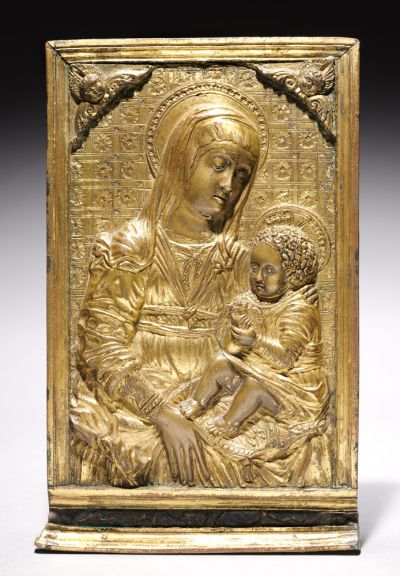The spread of the Franciscan and Dominican orders throughout Italy beginning in the 1200s resulted in the construction of many new churches in urban centers. Each of these churches had essential requirements for the celebration of the Mass and the performance of the sacraments. Every priest required a chalice and paten, vestments and a missal for use at the altar, as well as other sacral objects. The enormous demand for such liturgical objects for the use of the church undoubtedly provided employment for thousands of artists who specialized in their production.
Though today we continue to experience modern variants of objects such as reliquaries, censers, monstrances, chalices, patens, and vestments in today’s Catholic churches, their counterparts produced during the Middle Ages and the Renaissance are now seen primarily in museums or in ancient European church treasuries. The original functionality of these liturgical objects is not always clear to the modern layperson and their names may be equally enigmatic to the non-specialist. The terms “ostensorium” and “pyxides,” “dalmatic” and “lectionary” are hardly familiar, even to most modern Catholics. While many liturgical objects in use today would have been familiar to medieval Christians – the chalice and paten are perhaps the best examples – others have disappeared following the reforms to the liturgy after the Second Vatican Council.
One such object is the liturgical pax, an object no longer used by the church. A beautiful example is preserved in the Cleveland Museum of Art depicting the Madonna and Child. It was made in Florence during the late 1400s by a follower of artist Antonio Rossellino (1427-1479). The pax was an object used in the Middle Ages and Renaissance for the Kiss of Peace in the Catholic Mass. Direct kissing among the celebrants and congregation was replaced by each, in turn, kissing the pax, which was carried around and offered to those present by the priest. The Kiss of Peace had been included in the Roman Mass since the 2nd century. The pax began to replace actual kisses during the 13th century and its introduction is associated with the Franciscan Order. The person holding the pax said "Pax tecum" (Peace to you) and received the response "Et cum spiritu tuo" (And with your spirit). The pax gradually fell out of general use. In the 20th century, the physical kiss, now more often a handshake, was revived in the Mass.
The form of the liturgical pax was variable but normally included a flat surface to be kissed. Often the pax was held out with a long handle attached, and it seems to have been given a wipe with a cloth between each person. Some paxes are very elaborate and expensive objects, and most survivals fall into this class, but the great majority were probably very simple wood or brass pieces. It was usual to include a sacred image on the pax, usually of or including the Virgin Mary or Christ. The Cleveland pax measures 6 ¼ inches in height. It is made of gilt-bronze with a silvered frame and traces of blue enamel. It is a stunningly beautiful object in its own right. A small handle on the reverse would have been used by the priest in order to offer it to other celebrants at Mass and to the faithful for kissing.
The Madonna and Child composition on our pax has been linked to a lost marble relief by Antonio Rossellino, a well-known Florentine sculptor noted for his commissions of religious art for churches and private patrons. Our pax seems to have been produced in imitation of Rossellino’s marble relief by a skilled bronze artist familiar with that work. Liturgical paxes were produced in various materials including ivory, enamel and gilt-silver. By the 16th century, they had become larger and more ornate, since paxes were conspicuous objects seen by the faithful during the Mass. Most churches owned at least two. Like other liturgical objects, wealthy churches that could afford lavish and spectacular examples commissioned the most skilled artists to produce them in the most deluxe materials available.
Within the sacred confines of the church, the medieval churchgoer would have been overwhelmed by the sensory richness of the setting – the diffused and colored light emanating from stained glass windows or the flickering golden light from candles or oil lamps and the smell of incense as it ascended to heaven. In this ethereal world of God, the angels and the saints embellished with sculptures, icons and frescoes, the liturgical performance achieved an otherworldliness. Liturgical objects such as crosses, reliquaries and chalices, often dazzling for the shimmer of their gold and silver surfaces and the magic glow of the variegated gems and enamels, inspired the faithful in a way now difficult to imagine.
The Cleveland pax is such an object designed to impress by its beauty. Unfortunately, we do not know the identity of the church that originally owned it. However, one can still imagine the devotion of the numerous faithful in Renaissance Florence that would have kissed this stunning object.



